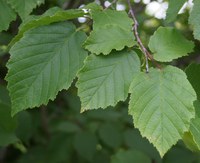Dakota Gardener: Make hay while the sun shines
(Click an image below to view a high-resolution image that can be downloaded)
By Joe Zeleznik, Forester
NDSU Extension
This phrase baffled me when I was young.
What did it really mean? My friend Kevin, who grew up on a farm and taught me about baling hay, told me that it has two meanings.
The first, literally, was to cut and bale hay when it would be sunny for a few days in a row. He didn’t want the fresh-mown hay to get rained on, for fear it would get moldy. Also, sunlight was critical to drying out the grasses and other plants in the cut hay.
The second meaning, though, was more symbolic. The expression means that you should make the most of the limited time you have. Another way of looking at this is to utilize the limited opportunities we have, to their fullest potential.
While trees clearly aren’t “making hay,” they’re being incredibly productive. Every day during the growing season, they’re making sugar. All they have to do is to add a little bit of water and some carbon dioxide, mix in sunlight, and voila! Sugar! The process is called photosynthesis and it’s fascinating.
The leaves are little food factories, creating all the carbohydrates that the trees will utilize for the entire year. It’s actually an incredibly complex process, yet it’s so simple. And it’s just those three simple ingredients – water, carbon dioxide and sunlight.
That sugar is just the beginning, though. After it’s produced, it begins to move around the tree, where it’s used to produce everything else.
The bark that protects the tree from the elements was once sugar that was produced in the leaves. The roots that are getting water and nutrients from the soil began as sugar, coming all the way from the opposite end of the tree. The wood in the stem that was produced 27 years ago started out as sugar. Along its journey within the tree, the sugar was combined with water and nutrients from the soil and was transformed. It then became cell walls and root tips, along with flowers, fruit and branches.
It’s a fascinating process. The complex organism of a hundred-year-old tree owes its entire existence to three ingredients that are used to make sugar.
Last week, we had the longest day of the year and the trees were making the most of it. They’re breathing in carbon dioxide from the air, combining it with water and sunlight, and turning into sugar. And that sugar is transformed into everything else.
Trees owe their physical structure to photosynthesis. But there are also biochemicals that trees utilize to fight off insects and diseases. You can guess where those all started out.
And that’s just the internal use of sugar. Beyond any individual tree, there’s a whole ecosystem that is being fed by the same process. What happens to the leaves that drop in autumn? They’re fed on by tiny organisms and get broken down by fungi and bacteria. Those little organisms get eaten by larger organisms and so forth. An entire ecosystem is being fed by the leaves of trees (and other plants).
It reminds me of another expression – busy as a bee. Trees are working like crazy, making the most of the time in our limited growing season. Admittedly, the process is hidden from view and for many people, it isn’t as fascinating as watching the bees move around. Nevertheless, like the bees, the trees are productive. They’re making sugar.
NDSU Agriculture Communication – June 27, 2023
Source: Joe Zeleznik, 701-730-3389, joseph.zeleznik@ndsu.edu
Editor: Kelli Anderson, 701-231-6136, kelli.c.anderson@ndsu.edu




